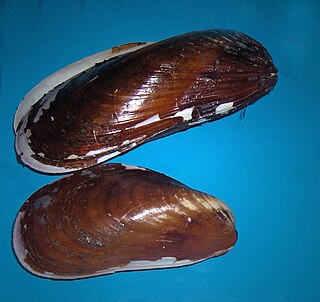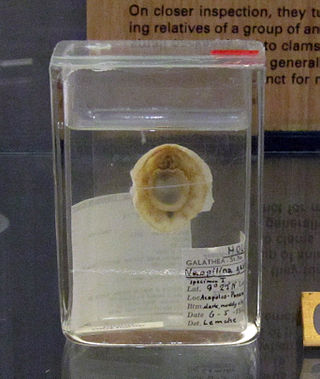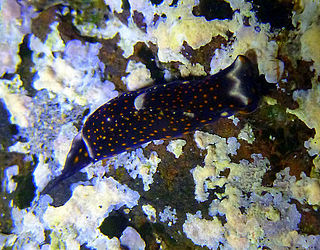
Chitons are marine molluscs of varying size in the class Polyplacophora, formerly known as Amphineura. About 940 extant and 430 fossil species are recognized.

The tusk shells or tooth shells, technically the Scaphopoda, are members of a class of shelled marine mollusc with worldwide distribution, and are the only class of exclusively infaunal marine molluscs. Shells of species within this class range in length 0.5–18 cm (0.20–7.09 in). Members of the order Dentaliida tend to be larger than those of the order Gadilida.

The gumboot chiton, also known as the giant western fiery chiton or giant Pacific chiton, is the largest of the chitons, growing to 36 cm (14 in) and capable of reaching a weight of more than 2 kg (4.4 lb). It is found along the shores of the northern Pacific Ocean from Central California to Alaska, across the Aleutian Islands to the Kamchatka Peninsula and south to Japan. It inhabits the lower intertidal and subtidal zones of rocky coastlines. The gumboot chiton's appearance has led some tidepoolers to refer to it, fondly, as the "wandering meatloaf". The name "gumboot chiton" seems to derive from a resemblance to part of a rubber Wellington boot or "gum rubber" boot.

The Patellogastropoda, common name true limpets and historically called the Docoglossa, are members of a major phylogenetic group of marine gastropods, treated by experts either as a clade or as a taxonomic order.

Acanthochitona zelandica is a species of chiton in the family Acanthochitonidae, also sometimes known as the hairy, or "tufted", chiton. It probably developed during the mid to late Pleistocene, and is endemic to New Zealand.

Tonicella lineata, commonly known as the lined chiton, is a species of chiton from the North Pacific.

Mopalia spectabilis, commonly known as the red-flecked mopalia, is a species of chiton.

Modiolus modiolus, common name northern horsemussel, is a species of marine bivalve mollusk in the family Mytilidae.

Splendrillia lucida is a species of sea snail, a marine gastropod mollusk in the family Drilliidae.

Mopalia ciliata is a chiton in the genus Mopalia, commonly known as the hairy chiton. It is a medium-sized marine mollusc up to 5.0 cm (2.0 in) in length. It is oval shaped with 8 separate, moderately elevated, overlapping ridged valves on its dorsal surface. Hairy chitons can be found along the coast of North America.

Katharina tunicata is commonly known as the black Katy chiton, black Leather chiton, black chiton, or leather chiton,, is a species of chiton in the family Mopaliidae.

Tryblidiida is a taxon of monoplacophoran molluscans containing the only extant representatives: 37 species are still alive today, inhabiting the ocean at depths of between 175 and 6,400 metres.

Donax vittatus, or the banded wedge shell, is a species of bivalve mollusc in the order Cardiida. It is found on beaches in northwest Europe buried in the sand on the lower shore.

Asthenosoma varium is a sea urchin. Growing up to 25 cm (10 in) in diameter, it lives on sand and rubble sea bottoms in the Indo-Pacific, from the Red Sea to Australia and Southern Japan. Its venom tipped spines, with distinctive globular swellings below the tip, can inflict a painful sting if handled; the pain lasts as long as several hours. This capacity, perhaps coupled with its reddish-brown colour, has given it the common name fire urchin; other commonly used names are Pacific fire urchin, elusive sea urchin, variable fire urchin, and electric sea urchin.
Dendropoma corallinaceum is a species of sea snail, a marine gastropod mollusk in the family Vermetidae, the worm snails or worm shells. It is a colonial species and forms aggregations on the lower shore near low-water mark. It is native to South Africa.

Myoxocephalus scorpioides, the Arctic sculpin or northern sculpin, is a species of marine ray-finned fish belonging to the family Cottidae, the typical sculpins. This fish is found in the Arctic Ocean.

Chiton olivaceus, the green chiton, is a species of chiton, a marine polyplacophoran mollusk in the family Chitonidae, the typical chitons.

Biuve fulvipunctata, the white-speckled headshield slug, is a species of sea slug or headshield slug, a marine opisthobranch gastropod mollusc in the family Aglajidae. This species is widespread in the Indian and Pacific Oceans but has invaded the Mediterranean Sea since 1961, despite apparently being absent from the Red Sea until recorded there in the 21st century. It is the only species in the monotypic genus Biuve.

Acanthochitona crinita is a species of marine chiton in the family Acanthochitonidae. It is found on rocky coasts in the northeastern Atlantic Ocean, the North Sea and the Mediterranean Sea.
Laonidae is a family of small marine snails belonging to the superfamily Philinoidea, though Laonidae and Philinoidea are genetically distinct. They are monophyletic, meaning they are developed from a single ancestor. Laonidae also has the synonymised name Laoninae, which is largely unaccepted in the modern day scientific community. The name Laoninae is introduced by Alice Pruvot-Fol who proposes it as the subfamily to the genea Loana, A.Adams 1865.

















